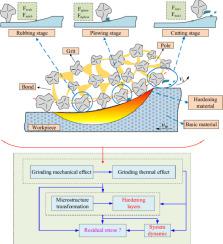当前位置:
X-MOL 学术
›
Int. J. Mech. Sci.
›
论文详情
Our official English website, www.x-mol.net, welcomes your
feedback! (Note: you will need to create a separate account there.)
Prediction on residual stress with mechanical-thermal and transformation coupled in DGH
International Journal of Mechanical Sciences ( IF 7.1 ) Pub Date : 2020-08-01 , DOI: 10.1016/j.ijmecsci.2020.105629 Cong Sun , Shichao Xiu , Yuan Hong , xiangna Kong , Yue Lu
International Journal of Mechanical Sciences ( IF 7.1 ) Pub Date : 2020-08-01 , DOI: 10.1016/j.ijmecsci.2020.105629 Cong Sun , Shichao Xiu , Yuan Hong , xiangna Kong , Yue Lu

|
Abstract The grinding hardening has played a major role in surface machining process combined with the mechanical engineering and the metallurgical behavior. Notably, the machining process is with system's dynamic, and a large amount of plastic deformations generate in the dynamic grinding hardening (DGH) process, which results in residual stress on the workpiece surface layers. To this end, the paper presents a novel model on predicting the residual stress considering the dynamic characteristic, the mechanical-thermal interaction and the transformation effect integrally. In this model, the analytic modeling on the mechanical-thermal coupling is established and treated as the input of the transformation firstly. Afterwards, the content of the hardening layers is calculated by the cellular automata (CA). Finally, the multi-phase field residual stress is established on the above factors, the results of which goes well with the DGH experiments. It shows that the consistency of the residual stress distribution varies a lot with the grinding position and the depth of cut. By comparison, the larger depth of cut at the stable grinding zone can bring about the compressive residual stress. This approach can enhance the recognization of formation mechanism of the DGH residual stress, and importantly can be a reference in optimizing the residual stress for manufacturing process.
中文翻译:

DGH中机械-热和转变耦合的残余应力预测
摘要 磨削硬化与机械工程和冶金行为相结合,在表面加工过程中发挥了重要作用。值得注意的是,加工过程具有系统的动态性,动态磨削硬化(DGH)过程中会产生大量塑性变形,从而导致工件表层产生残余应力。为此,本文提出了一种综合考虑动态特性、机械-热相互作用和转换效应的残余应力预测模型。在该模型中,首先建立了机械-热耦合的解析模型,并将其作为转换的输入。之后,硬化层的含量由元胞自动机(CA)计算。最后,多相场残余应力建立在上述因素的基础上,其结果与DGH实验相吻合。表明残余应力分布的一致性随磨削位置和切削深度变化很大。相比之下,稳定磨削区较大的切削深度会带来残余压应力。该方法可以提高对DGH残余应力形成机制的认识,重要的是可以为制造工艺优化残余应力提供参考。稳定磨削区较大的切削深度会带来残余压应力。该方法可以提高对DGH残余应力形成机制的认识,重要的是可以为制造工艺优化残余应力提供参考。稳定磨削区较大的切削深度会带来残余压应力。该方法可以提高对DGH残余应力形成机制的认识,重要的是可以为制造工艺优化残余应力提供参考。
更新日期:2020-08-01
中文翻译:

DGH中机械-热和转变耦合的残余应力预测
摘要 磨削硬化与机械工程和冶金行为相结合,在表面加工过程中发挥了重要作用。值得注意的是,加工过程具有系统的动态性,动态磨削硬化(DGH)过程中会产生大量塑性变形,从而导致工件表层产生残余应力。为此,本文提出了一种综合考虑动态特性、机械-热相互作用和转换效应的残余应力预测模型。在该模型中,首先建立了机械-热耦合的解析模型,并将其作为转换的输入。之后,硬化层的含量由元胞自动机(CA)计算。最后,多相场残余应力建立在上述因素的基础上,其结果与DGH实验相吻合。表明残余应力分布的一致性随磨削位置和切削深度变化很大。相比之下,稳定磨削区较大的切削深度会带来残余压应力。该方法可以提高对DGH残余应力形成机制的认识,重要的是可以为制造工艺优化残余应力提供参考。稳定磨削区较大的切削深度会带来残余压应力。该方法可以提高对DGH残余应力形成机制的认识,重要的是可以为制造工艺优化残余应力提供参考。稳定磨削区较大的切削深度会带来残余压应力。该方法可以提高对DGH残余应力形成机制的认识,重要的是可以为制造工艺优化残余应力提供参考。











































 京公网安备 11010802027423号
京公网安备 11010802027423号